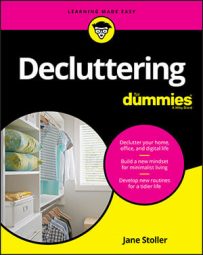Don’t label things you don’t use or that don’t add value to your life. It is useless to have beautiful labeled boxes with items in them that you never use — this is just a clutter trap! However, labeling boxes of items that you actually use on a regular basis is a decluttering game-changer. Plus, making the boxes pretty never hurts!
Your lifestyle determines what labels you need, how long they will last, and whether they change regularly. Your lifestyle also determines the look of the labels and how fast you need them. You don’t need perfectly color-coordinated labels with your personal branding or business logo on them for everything. Of course, they would look amazing! But when you’re quickly labeling your fridge items or making a temporary label for a work project, speed and functionality take priority over aesthetics.
Labels don’t have to be forever. They usually only last for a certain period. I have not had many labels last more than a few years before an update is needed. I recommend updating them frequently and adding this to your regular decluttering routine.
The following sections cover different types of labels, ways to make labels, and recommendations for how you can use them.Label maker
I love my label maker. I really do. It sits beside me on my computer when I’m working, and I miss it when I’m traveling. I love making labels, and a label maker makes them all perfectly uniform to give my items a polished look.Following is a picture of my label maker, the bigger version that the brand Brother offers. I also have a smaller handheld version that I keep in my Bahamas home, as, of course, I make labels there as well.
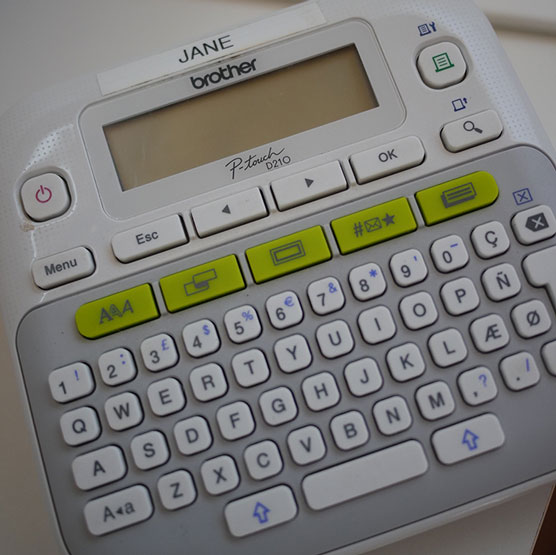 Image courtesy of Jane Stoller
Image courtesy of Jane StollerMy label maker.
The next figure shows how I always make sure I have at least two replacement label cassettes, as you don’t want to be in the midst of a labeling project when your cassette runs out!
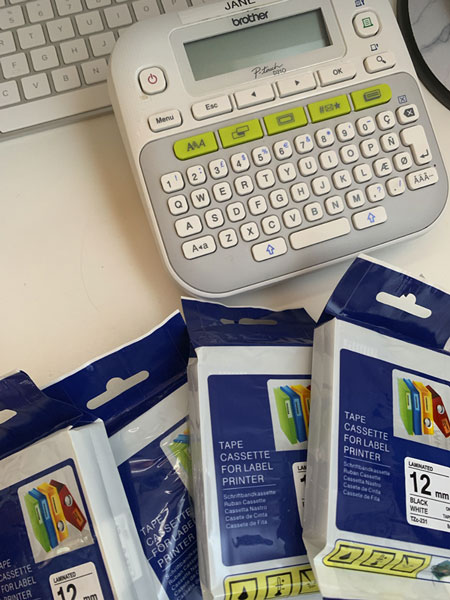 Image courtesy of Jane Stoller
Image courtesy of Jane StollerSpare label cassettes on hand.
Label makers are great for quick labels and those that need to be changed frequently. My rule of thumb is that if you need to make ten or fewer labels at a time, then a label maker is perfect. This figure shows an example of what a label-maker label looks like.
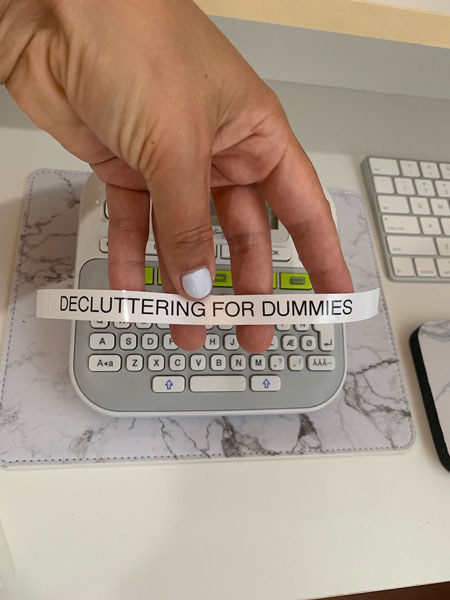 Image courtesy of Jane Stoller
Image courtesy of Jane StollerExample of standard label-maker labels.
Computer labels
When my dad came to me and asked to borrow my label maker, I was ecstatic. I was not ecstatic when I saw him take five minutes to print one label and saw that he wanted to label his entire wall of small nails, screws, and washers. There were more than 100 drawers, which would take him months! I instead suggested he sit down beside me for an hour while I made computer labels using a Microsoft Word document with the Avery labels template in size 1” x 2-5/8” rectangle labels.I printed the labels, and an hour later my dad was happily placing them on all of his drawers. He is now forever able to find all types of screws, nails, or washers whenever he needs them.
The reason for this story is that there is a time and place for different labels. If you have to make more than ten labels, I suggest using a computer for faster results. Plus, you will then get to know the standard label sizes you are always reaching for and can keep those on hand.
In your Microsoft Word program, under “Tools,” you can choose “Labels.” Then, there is a drop-down menu of many different label sizes and the number it corresponds to from the supplier. Avery is the most standard one. This is the easiest way to create labels on the computer because the template gives you the correct label size.I also use computer labels for mailing items. I rarely handwrite addresses; I use shipping and return labels, as they look more professional.
I always keep my most-used Avery labels on hand.
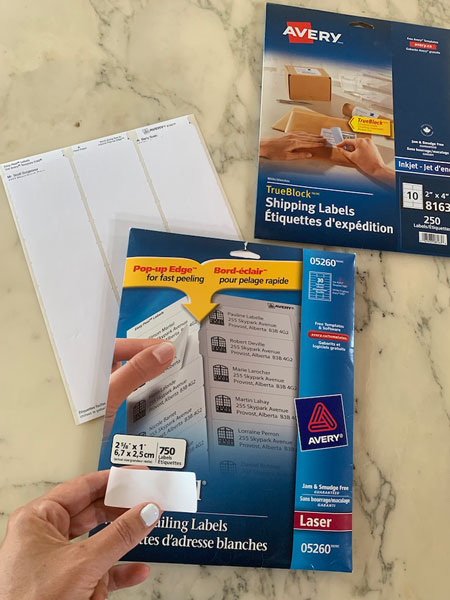 Image courtesy of author
Image courtesy of authorExample of my most-used Avery computer labels.
The beauty of computer labels is they are fast and can be customized. The downside is that you can’t throw a computer and printer in your purse to make labels on-the-go.
I suggest computer labels for anything you need to customize or want to look pretty. And of course, if you have to do ten or more labels, it’s much quicker, providing you have a printer. You can also send them to your local print shop if you don’t have a printer or if you don’t want to make them yourself.
Following is an example of my customized computer labels.
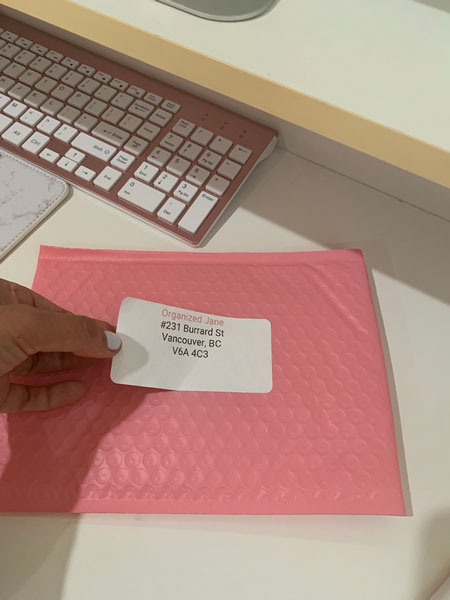 Image courtesy of author
Image courtesy of authorAn example of a computer label.
Handwritten labels
I still love handwriting letters and labels, and I do this often. At the moment, I am planning a large lifestyle photo shoot for my business, and I wrote all the labels by hand. It’s quick, and they are only being used for one event, so handwriting these is efficient.The term “label” doesn’t necessarily have to refer to a sticky label. The following shows cardboard labels that can be attached with a string or slip over something, such as a hanger.
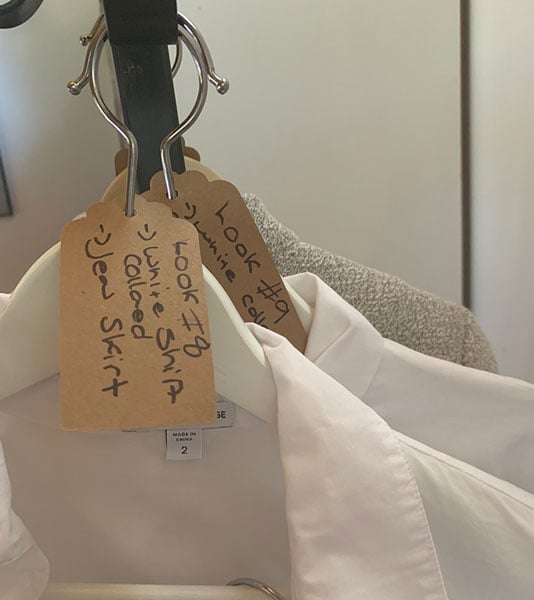 Image courtesy of Jane Stollen
Image courtesy of Jane StollenA handwritten label.
Permanent labels
Sometimes you want to label something permanently. In this case, you want to engrave your items or use labels that are sewn or crazy-glued on, or done with permanent marker. When I think of permanent labels, I think of them on clothing or totes. For example, my luggage has a permanent label on it. However, make sure you only permanently label something when you are absolutely sure the name or letters will never change.Also, many stores do personalization or permanent labeling for you. The store where I bought my suitcase, shown here, offered this service.
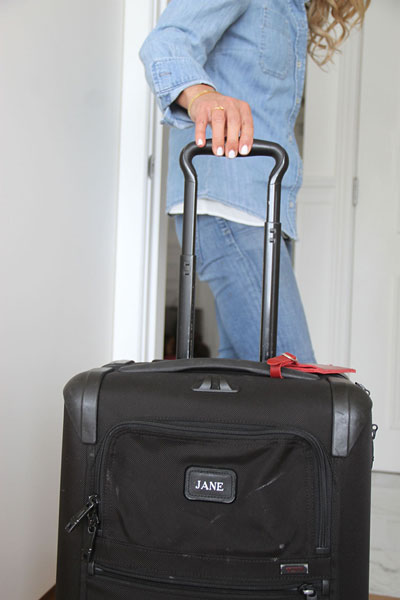 Image courtesy of Jane Stollen
Image courtesy of Jane StollenSuitcase label.
Washable labels
Perhaps you need to write something on a plastic storage container, but you need to change the label whenever a different food item goes in it. Getting a washable marker and keeping it within reach of where you label is a great idea. Then, once you don’t need the label or want to change it, you can simply wash it off. This is also great for events on whiteboards where you need to label directions or entranceways.Prewritten labels
You can order labels that already have words on them or make custom ones. My favorite site is Mabel’s Labels, as she has already made a label for practically everything you can imagine needing a label for. Plus, she can give you great ideas and inspiration! This site is especially great for kids’ labels, and if your kids start labeling now, they likely will continue this healthy habit into adulthood.Picture labels
Who said that a label has to be written? You can use photos to help identify what is in boxes instead of listing the item(s). Doing this was easier when we had Polaroid cameras; however, it doesn’t take long to print the photos on your printer.Check out the following figure to see how I quickly label my shoeboxes with a photo so I know what’s inside.
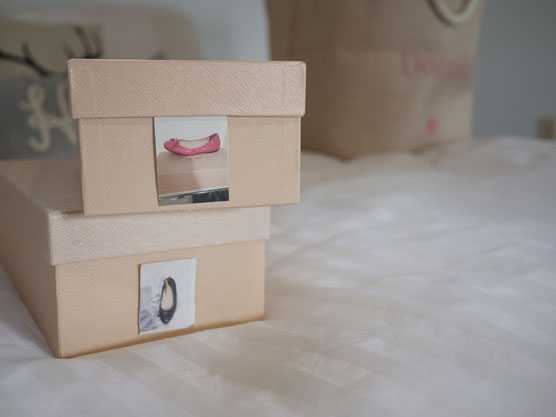 Image courtesy of Jane Stollen
Image courtesy of Jane StollenPhoto labeling of my shoeboxes.
Label apps
A label doesn’t have to be physical. You can make digital labels on your phone using apps like Snupps, which is basically an app to organize anything.If you have a box and don’t have any labels, why not start a shelf or list on your phone of what is inside? The great thing about this is that you can share the information or quickly edit it, and you even save paper. Plus, when you’re away from home, you’ll always know what you have.
Food labels
Earlier I give an example of washable labels, which are great for food; your food containers’ contents can change so quickly! Labeling freezer items is also very important. If you don’t, you risk your items getting freezer burn. Use a marker or sticker label to simply label what you put in your freezer and the date you put it in. If the package isn’t see-through, for example packaged meat from the butcher, make sure you label what it is and the date.Danger labels
If something is dangerous, it needs to be labeled to let people know. This can be for chemicals in spray bottles, medication, or larger hazards such as equipment or even where not to enter.Ensure any hazards around your work and home are labeled to let people know of the dangers. Just because you know something is dangerous doesn’t mean your kids’ babysitter will. Be safe rather than sorry and label anything dangerous.
What and when not to label
I love labeling, and I know it helps to increase efficiency! But there are some things I don’t label because I don’t want anyone to know what is in them. Here are some items I don’t label or times when not labeling makes sense:- Jewelry: Call me crazy, but I have this fear that if someone breaks in and sees a box or drawer labeled “jewelry,” it will be the first thing they steal.
- Money: I believe in labeling folders for your personal documents, but if you keep a stash of money at home or the office, it’s best not to label the envelope or box for the same reason noted in the preceding bullet.
- Moving: When you’re moving, of course you need to label! However, if you are having professional movers move the boxes, or if your items might be exposed to the public on the street or during transit, it’s best not to label valuables, such as jewelry (which you shouldn’t have movers move anyway), valuable antiques, and whatever else might be enticing if someone sees the label.
- Anything super personal: If seeing a label may cause shock or curiosity in a potential guest, it’s best not to label that item. Some things are meant to be kept personal, and if you label them, someone may find them alluring.
- When you don’t want someone to know your name or address: When I was interviewing parents for this book, I found out that some parents don’t like to put names on items that are seen in public, such as backpacks, towels, or clothes. A hidden label (for example, inside a backpack) is okay to help identify items; however, one mother advised not to label anything obvious because you don’t want your young kids to think that strangers know them.

